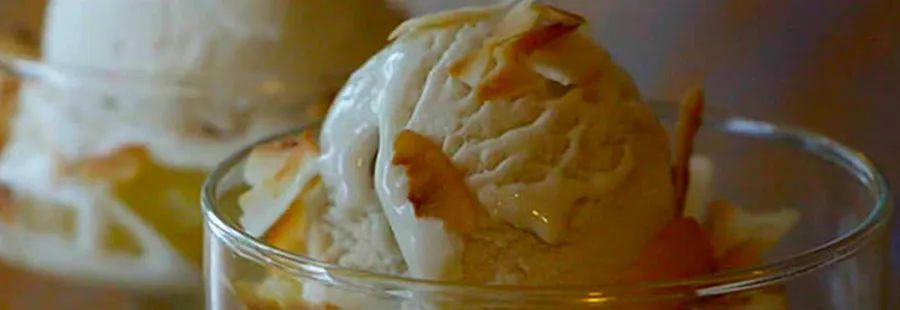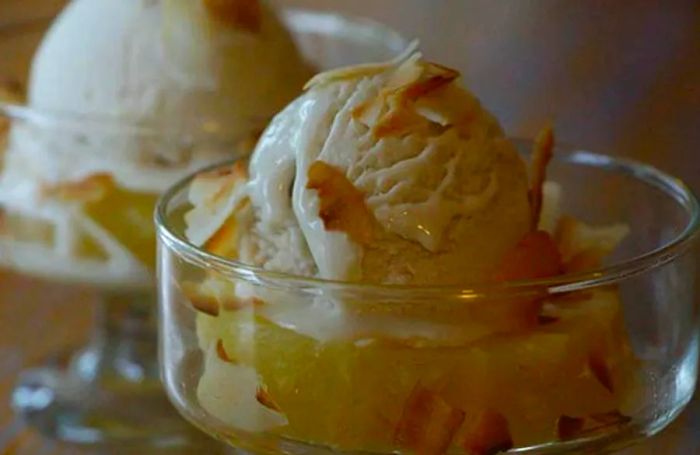Coconut Rum Gelato

During our exploration of San Juan on the Dinogo cruise, we dined at a renowned restaurant known as the birthplace of the beloved vacation cocktail — the Pina Colada. Enjoying lunch at this iconic spot, La Barrachina, while gazing at the Bacardi Rum Factory across the bay during our stroll around Old San Juan, I felt inspired to whip up a recipe that captures the essence of Puerto Rico's flavors at home.
I began with a dairy-free coconut gelato recipe using coconut milk, a foundational recipe I discovered on The Kitchn. Then, I incorporated pineapple, rum, and toasted coconut flakes to transform it into a delightful Pina Colada-flavored treat. It's incredibly creamy and delicious, embodying the taste of summer.
At first glance, this recipe might seem time-consuming to prepare. Don’t let that discourage you! It only requires about 20 minutes of cooking on the stove, and the rest of the time is simply waiting for the ice cream to set in the freezer.
Check out the step-by-step photos below, and at the end of the post, I’ve included a button to print the recipe.
Dig in!

Ingredients List:
- 2 (13-ounce) cans of full-fat coconut milk
- 1/2 cup of cane sugar
- 1/4 teaspoon of salt
- 2 tablespoons of cornstarch
- 1 1/2 teaspoons of vanilla extract
- 1 20-ounce can of sliced pineapple rings
- 1 8-ounce can of crushed pineapple
- 1/2 cup of organic coconut flakes
- 2 ounces of Puerto Rican rum
Essential Equipment: Ice Cream Maker
Instructions:
(Note: Be sure to adhere to your ice cream machine’s guidelines for freezing. Some models require the bowl to be frozen for 24 hours, while others may need a box of rock salt to reach the right temperature. Make sure to prepare this in advance so it's ready for making your ice cream.)
1. Begin by shaking the cans of coconut milk.
Using canned coconut milk instead of the carton version is crucial because it’s much creamier, thanks to the fat content. However, the creamy portion often separates from the liquid, which is why it's best to give it a good shake while it's still in the can. I even had a little fun and danced around the kitchen like I was playing maracas!

2. Open the cans and measure out 1/2 cup of the coconut milk, setting it aside. Pour the rest of the coconut milk into a saucepan and heat it on low.

3. Combine the cornstarch with the 1/2 cup of coconut milk and whisk until fully dissolved. Set it aside for later use.

4. Then, add the sugar and salt to the saucepan with coconut milk, stirring vigorously until everything is completely dissolved. This should take about two minutes. After the sugar has dissolved, incorporate the remaining 1/2 cup of coconut milk mixed with the cornstarch.

5. Raise the heat to medium-low and stir the mixture with a wooden spoon until it thickens enough to coat the back of the spoon. This process should take about seven to eight minutes. Avoid speeding up the process by turning up the heat, as you want to prevent burning at the bottom of the pan or letting it boil over.

6. Once the mixture has thickened, take the saucepan off the heat, place it on a trivet, and stir in the vanilla and rum.

7. Allow the mixture to cool to room temperature (approximately 20 minutes), then transfer it to a glass bowl. Press a piece of plastic wrap against the surface to ensure it’s airtight and prevent a skin from developing. Let the mixture cool for at least 4 hours or overnight.

8. Once your ice cream base has cooled, it’s time to churn it in your ice cream maker. Pour the mixture into the machine and follow the manufacturer’s instructions for churning. Generally, it takes about 8 to 10 minutes to achieve a soft serve consistency.

9. While the ice cream is churning, drain the can of crushed pineapple and press it between two paper towels to eliminate any excess moisture. Add the crushed pineapple to the ice cream during the last 2 to 3 minutes of churning.

10. At this stage, the ice cream will have a soft serve consistency. You can either enjoy it immediately or freeze it for a firmer, scoopable texture. Use a spatula to transfer the ice cream from the machine into a freezer-safe container. A helpful tip I learned from The Kitchn is to place a sheet of parchment or wax paper on the surface to prevent ice crystals from forming, which works wonderfully. After about 4 hours, your ice cream will be solidified and ready to serve.

11. While the ice cream is firming up in the freezer, add the coconut flakes to a dry frying pan for toasting. (Note: It's best to use organic flakes, as the shredded coconut commonly found in the baking aisle often contains added oils that hinder the toasting process.) No oil is necessary; just add the coconut dry and set the heat to medium. After a minute or two, they will begin to brown. Stir with a wooden spoon to ensure all pieces toast evenly. Once they reach a golden caramel color, transfer them to a bowl and set aside to cool. This will be your topping.

12. To get ready for serving, open the can of pineapple rings and drain the juice. Place one or two rings in each serving bowl, add a scoop of Coconut Rum Ice Cream, and sprinkle with the toasted coconut flakes.

Alternatives:
— You can skip the pineapple and add a teaspoon of cinnamon along with half a teaspoon of nutmeg to create a different Puerto Rican flavor — Coquito Ice Cream.
— You can leave out the rum for a non-alcoholic version.
— You can also exclude the pineapple and serve the ice cream with caramelized bananas or maduros (fried sweet plantains).

This article was crafted for Away We Go with Dinogo, your go-to source for embracing that vacation vibe.
Evaluation :
5/5



